By Ben Lewis
March 23, 2023
Starting in September of 2020, Taiwan’s Ministry of National Defense (MND) began releasing reports on flights by People’s Liberation Army (PLA) aircraft into their self-proclaimed Air Defense Identification Zone (ADIZ). Since then, ADIZ violations have become the most frequent method of “gray zone” pressure used against Taiwan by Beijing, with flights taking place on a near-daily basis. Of the two-and-a-half years of data available on these activities, 2022 saw the most significant developments. This analysis provides an overview of key trends in ADIZ violations in 2022.
As a precursor to discussing 2022’s developments, a few parameters are necessary to help scope the analysis. First, this analysis is based on data collected from the official releases on ADIZ activity by the Taiwan MND. Other information about PLA activity in the ADIZ are considered but are not included in the quantitative analysis.
Second, since the data for 2020 only spans the last four months of the year, 2022’s full year of data is compared to 2021’s full year of data for the sake of accuracy.
Third, the term “violation” when used to describe flights into the ADIZ is not an official description of the activity, as there is no international legal framework for the establishment and enforcement of an ADIZ. Instead, it is used to describe a violation of international norms surrounding typical ADIZ procedure.
Fourth, Taiwan’s claimed ADIZ covers large portions of mainland China. The MND, however, does not count PLA aircraft operating inside China’s recognized territorial airspace as ADIZ violations. Only aircraft that enter Taiwan’s “de facto” ADIZ are counted in the reports (Figure 1). Further, the ADIZ data does not include flights over Kinmen, Matsu, Wuqiu, or Pratas, as they are outside the geographic area covered by the de facto ADIZ.
Figure 1: Taiwan’s De Facto ADIZ
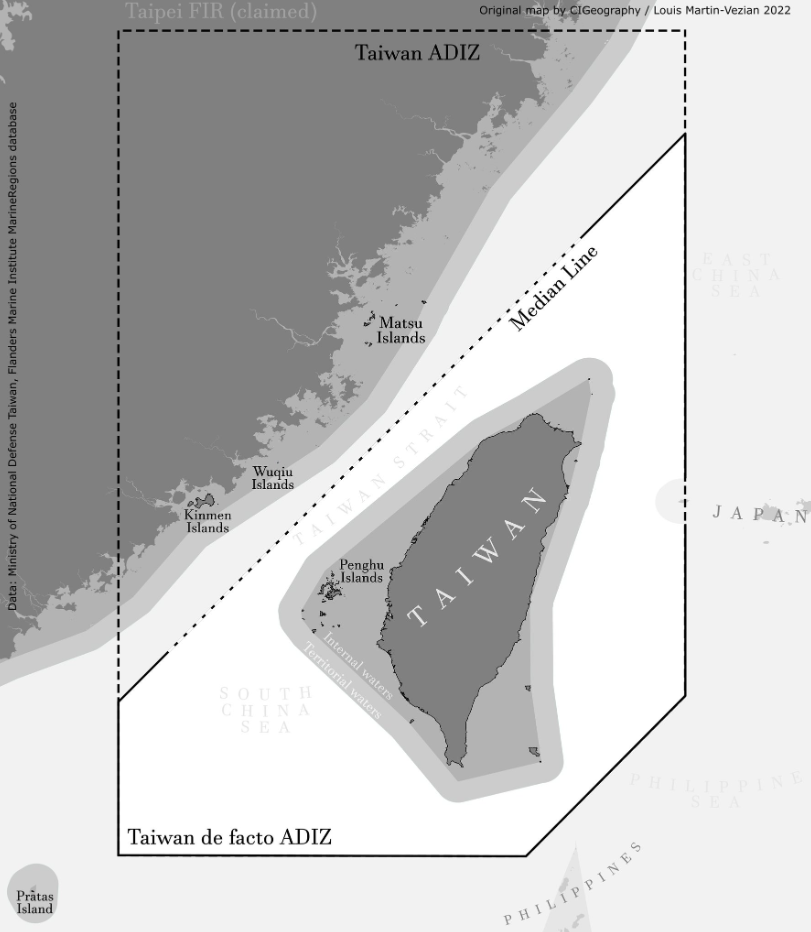
Click to enlarge. View source information below.
Finally, the ADIZ is not Taiwan’s territorial airspace as defined by international law, and no PLA aircraft have been publicly tracked operating inside Taiwan’s territorial airspace. Taiwan’s ADIZ acts as a security buffer zone to monitor incoming aircraft.
With these parameters established, it is possible discuss the developments from 2022.
Larger and More Frequent ADIZ Violations
In total, 1,737 aircraft were tracked in the ADIZ in 2022, a 79 percent increase from 2021 (972). The average number of monthly and daily aircraft likewise saw a significant increase to 144.75 (from 81), and 6.48 (from 4.05) respectively. The total number of days with violations increased from 240 in 2021 to 268 in 2022.
Using data from 2020 and 2021, three types of violations can be established: routine violations involving one to five aircraft, assertive violations involving six to nine aircraft, and reactionary violations involving 10 or more aircraft. Most reactionary violations are tied to geopolitical developments involving Taiwan, the United States, and other regional powers that Beijing believes are contrary to its “One China Principle.” In 2021, reactionary violation days made up 8.8 percent of all days when violations took place. In 2022, reactionary violations made up 20.5 percent, a major increase.
Three reactionary violations stood out in 2022. On August 5, 49 aircraft were tracked in Taiwan’s ADIZ in response to then-Speaker of the House Nancy Pelosi’s visit to Taiwan. On December 25, 47 aircraft entered the ADIZ in apparent response to the passage of the 2023 U.S. National Defense Authorization Act, which included multiple provisions supporting Taiwan. Finally, on January 23, the PLA flew 39 aircraft into the ADIZ after the Arm Taiwan Act of 2022 was proposed in the U.S. House of Representatives (see Figures 2-4). Overall, the large number of aircraft has raised the daily average from a routine violation to an assertive violation, an additional indication of increased activity.
Figures 2-4
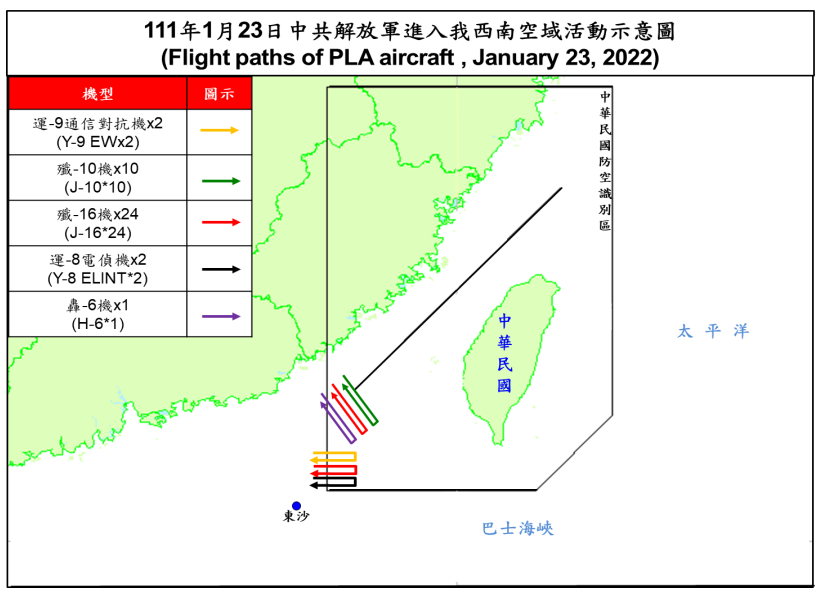
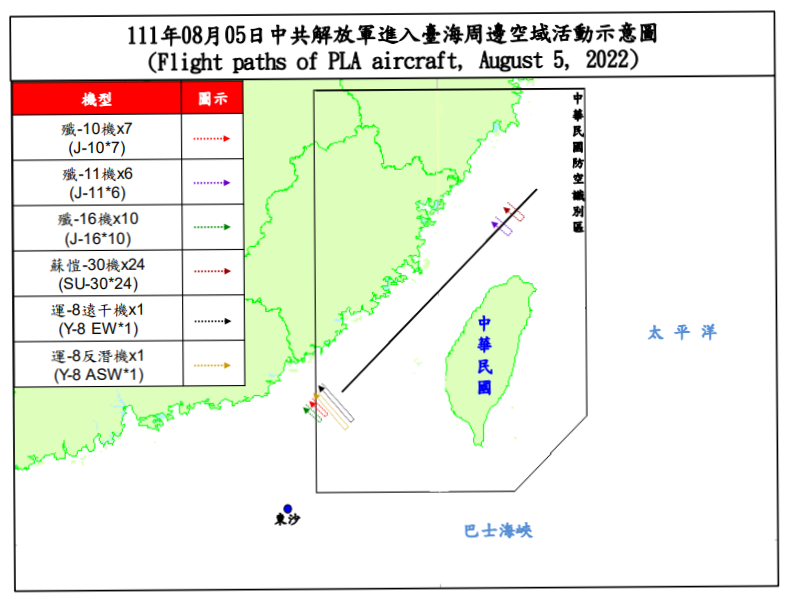

Click to enlarge. View source information below.
Increasing Diversity and Complexity
Throughout 2022, PLA violations of the ADIZ began involving increasingly diverse combinations of aircraft conducting more complex operations. Starting on September 5, 2022, the Taiwan MND began releasing public information about PLA unmanned aerial vehicles (UAVs) operating in the ADIZ. Since that time, UAVs have made up around 10 percent of aircraft tracked in the ADIZ, which is further evidence of the increasing diversity of aircraft involved in these activities.1
Figure 5 shows the most complex and diverse set of violations in 2022. This included J-16 fighters, H-6 strategic bombers, and a KJ-500 airborne early warning and command (AEW&C) aircraft conducting extended flights and an aerial refueling exercise with a Y-20U tanker aircraft. It also included a CH-4 UAV conducting a median line crossing and multiple aircraft operating in the Southwest ADIZ, including a ship-launched Z-9 anti-submarine warfare (ASW) helicopter, a KJ-500 AEW&C aircraft, and additional J-16 fighters. Since Y-20s are currently believed to only be based in the Central Theater Command, this suggests that this exercise involved forces from across multiple theater commands. This example is emblematic of the trends in complexity and diversity of ADIZ violations in 2022.
Figure 5
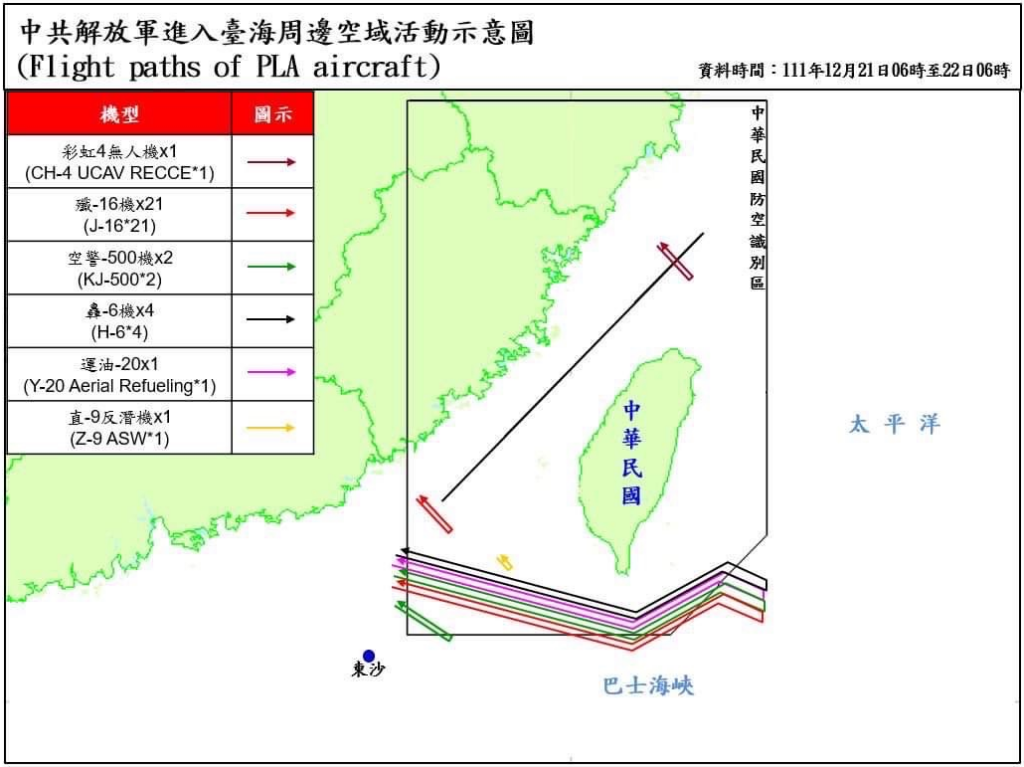
Click to enlarge. View source information below.
The Altered Status Quo in the Taiwan Strait
In response to then-Speaker Pelosi’s visit to Taiwan in early August, the PLA conducted unprecedented military exercises around Taiwan. As a result of these exercises and the heightened military presence around Taiwan throughout the entire month of August, 446 aircraft were tracked operating in the ADIZ, the highest one-month total on record.
While the high quantity of aircraft itself degraded the status quo, Beijing specifically used its exercises to functionally erase the median line boundary of the Taiwan Strait. The median line was drawn in 1954 by the United States and has served as the unofficial boundary between the PRC and Taiwan since that time, though Beijing has never accepted the line’s legitimacy. In August, 302 PLA aircraft were tracked crossing the median line, and from September 1 to December 31, an additional 261 PLA aircraft were tracked. In total 564 PLA aircraft were tracked crossing the median line in 2022, more than 24 times the total of known median line crossings prior to the Pelosi visit. The erasure of the median line has permanently altered the status quo of the Taiwan Strait.
Figure 6: Taiwan’s De Facto ADIZ with Area Groupings and 2022 Totals
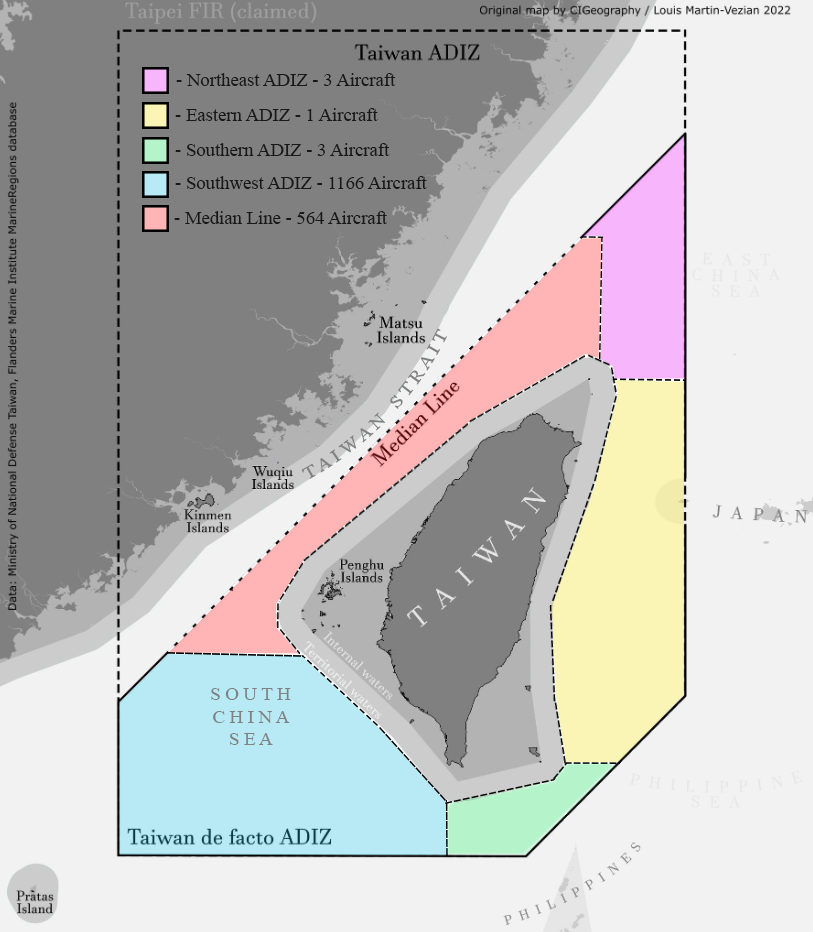
Click to enlarge. View source information below.
The available information on ADIZ violations provides important insights into PLA activity around Taiwan, and it also prompts a number of equally important questions. We know little about what PLA aviation units are involved in these flights, or what level of the PLA oversees their planning and execution. We likewise cannot be sure how much information Taiwan’s MND is withholding from its reports or whether it is missing some activity.
Most importantly, however, we have no way of knowing how far these activities will go, how large they may become, or how far Beijing will push the envelope. Further, the more Beijing turns up the dial with its military pressure, the higher the chance for an accident or miscalculation. It is therefore vital that the international community push back against this behavior to prevent it from being considered routine.
Ben Lewis is an independent defense analyst based in Washington, D.C., focused on the People’s Liberation Army and Taiwan security issues. He manages an English-language database tracking PLA incursions in Taiwan’s Air Defense Identification Zone. Follow him on Twitter @OfficialBen_L.
All views, positions, and conclusions expressed in this publication should be understood to be solely those of the author(s).
Map Sources:
Louis Martin-Vezian of CIGeography, 2022; R.O.C. Ministry of National Defense; R.O.C. Ministry of National Defense; R.O.C. Ministry of National Defense; R.O.C. Ministry of National Defense; Louis Martin-Vezian of CIGeography, Alex O’Neill of Onisoft Games, 2022.

